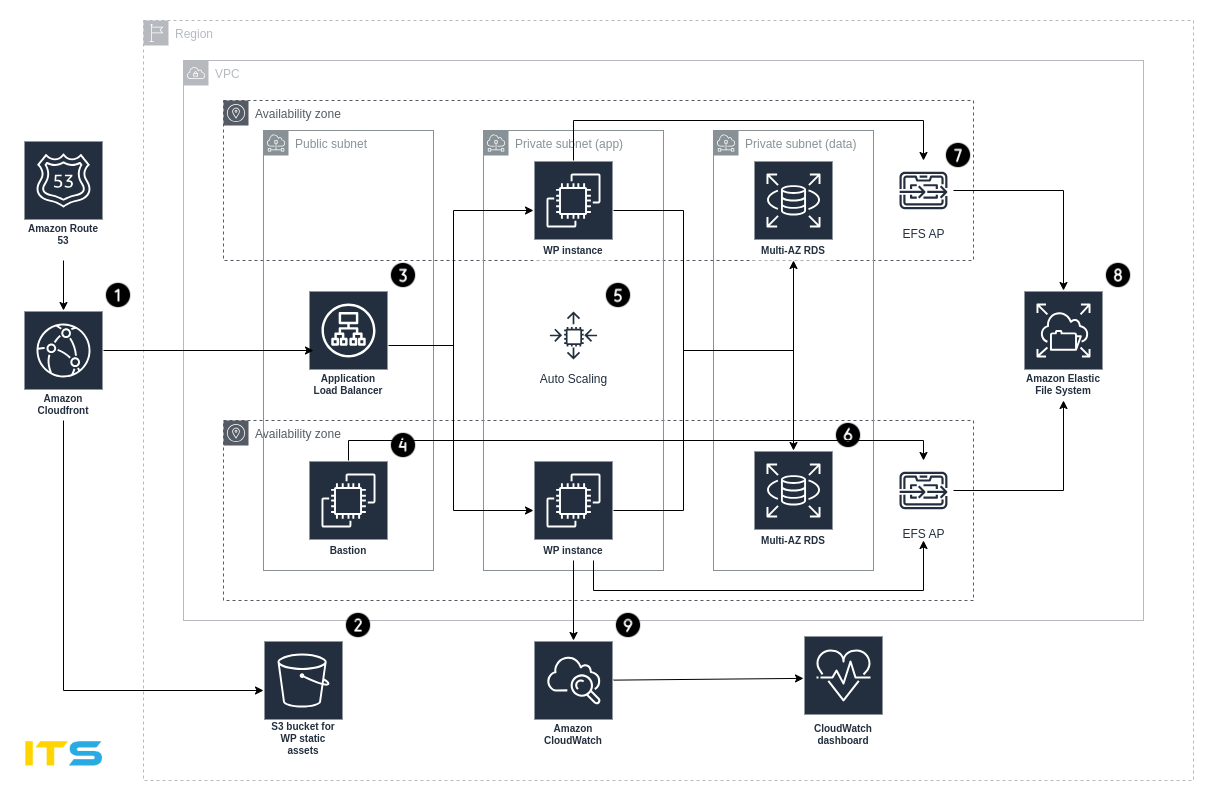A practical guide for DevOps Engineers and Cloud Architects
The fast-changing world requires secure, flexible, and efficient cloud solutions. The AWS Well-Architected Framework conception aims to keep up with all the changes in informational technologies and aid cloud solution architects in their work. This how-to guide will help you understand the Framework's main advantages and disadvantages while providing general information on architectural best practices for working with the cloud.
What is the AWS Well-Architected Framework
AWS Well-Architected Framework is a tool that aims to help cloud solution architects deploy secure, flexible, high-performance, efficient, sustainable, and reliable infrastructure for various applications and workloads. AWS solutions architects have developed the tool, a collection of their best practices, design considerations, and key principles for building stable, efficient, and secure environments in the AWS cloud. It stands on six so-called "pillars" that essentially are cornerstones of AWS's main concepts, principles, and practices: Operational Excellence Pillar, Security Pillar, Reliability Pillar, Performance Efficiency Pillar, Cost Optimization Pillar, and Sustainability Pillar. There are also AWS Well-Architected Lenses and AWS Well-Architected Guidance, which we will cover, along with the Six Pillars, shortly below.
The six pillars of the AWS Well-Architected Framework
Each pillar covers a specific area of concepts and principles, implementing which will ensure the application is well-architected and provides value over time.
- Operational Excellence Pillar focuses on system execution, monitoring, and continual improvement of procedures. This pillar covers events response, daily operations management, change automation, and more.
- The Security Pillar is all about the confidentiality of data, the management of user permissions and security events, and the establishment of control. This pillar focuses on securing and protecting both information and systems.
- The Reliability Pillar is the pillar that concerns recovery planning and distributed system design, ensuring the workload performs as it is supposed to and the demands are met even in case of failure and subsequent, efficient restoration.
- The Performance Efficiency Pillar stands for structuring and streamlining resources, both in IT and computing. This pillar covers selecting the appropriate resource sizes and types for the workload while maintaining efficiency and monitoring performance.
- The Cost Optimization Pillar is self-explanatory and focuses on avoiding all unnecessary expenditures. This pillar covers expenditures over time, money, and resource allocation for quality, quantity, and scalability.
- The Sustainability Pillar is the environmental pillar that focuses on minimization of the environmental impact of cloud workloads. This pillar covers the reduction of downstream impact, minimization of required resources and misuse of byproducts, and a shared responsibility model for sustainability.
There are many interpretations and adaptations of the AWS Well-Architected Framework pillars on the internet, and you may omit some of them. However, these pillars cover distinct aspects of architecture and are meant to provide all aspects of a well-architected, balanced design.
Get expert insights to fine-tune your AWS environment, focusing on security, performance, and cost optimization using cloud-native best practices.
AWS Well-Architected lenses and guidance
While both of them serve the primary duty of providing guidance, they are actually different in approach and scale.
Lenses, like Framework, are aligned with all Six Pillars and focus on industry and technology, such as data analytics, ML, HPC, IoT, SAP, the games industry, and more. You can use applicable Well-Architected Lenses with Framework and its Six Pillars to fully evaluate your workload. Examples of well-architected lenses are migration, data analytical, and serverless applications.
AWS Well-Architected Guidance, on the other hand, focuses on specific implementation scenarios, use cases, or technologies. Unfortunately, Amazon provides only six such use cases on their website: management and governance of cloud environments, disaster recovery, operational readiness reviews, reducing the scope of impact (cell-based architecture), guidance for DevOps, and, the newest one, change enablement in the cloud. While not superfluous, it still elaborates on a wide variety of scenarios, whereas niche situations may be covered by WAGE - AWS Well-Architected Guidance Engine that was added to the AWS Control Tower at the end of 2020.
AWS Well-Architected tool
AWS offers using their Well-Architected Tool to architects and engineers for framework implementation, as it provides a structured and organized approach for checking your architecture covering the Six Pillars. Using the Tool, you can review and measure your workloads, identify risks and gaps, and assess the ongoing situation through the generated reports - the information on how you can make improvements is provided. Please proceed to the step-by-step guide on using the Tool efficiently.
Step-by-step guide to implementing the AWS Well-Architected Framework
- Define Your Workload and Business Objectives
Clearly defining your workload and business objectives is essential: you need to identify all the key objects, expeditions, and expected outcomes before implementing the Framework. You should also consider most if not all, potential risks because having no clear objectives and defined potential risks may play a detrimental role in the design. - Conduct a Well-Architected Review
Employ the AWS Well-Architected Tool and review your architecture: it may be an already existing one or the new one you are currently designing. The Tool compares the details against the best practices of Six Pillars and evaluates how your work may be potentially improved, providing all the insights via the generated report. - Implement improvements
You need to implement the offered improvements to observe the changes. There are numerous possible improvements for every unique case, thus, we shall provide you with the most common ones for each of the Six Pillars:
Operational excellence
- Monitoring and Logging: deploy monitoring and logging practices using services like Amazon CloudWatch to track the performance of your workloads.
- Automation: automate your processes via AWS Lambda and AWS Systems Manager, thus ensuring consistency and reliability in your daily operations management.
Security
- Identity and Access Management: Protect your system via AWS IAM by reviewing security events, managing resource availability and permissions, and deploying multi-factor authentication (MFA) for added security.
- Data Protection: ensure the confidentiality of data and protect the information from unauthorized actors. Implement regular security reviews and compliance checks via AWS Key Management Service (KMS).
Reliability
- Resilient Design: improve your system in failure handling by including Cross-Region Replication in Amazon S3 for critical services.
- Backup and Recovery: Amazon Backup will manage automated backups and disaster recovery solutions to ensure you always have restoration points.
Performance efficiency
- Right Sizing: Evaluate your workload demands and use the appropriate storage size. Amazon EC2 Auto Scaling will help you scale your resources automatically.
- Caching: deploy caching strategies via Amazon CloudFront and Amazon ElastiCache - improve the performance and reduce latency for your end-users.
Cost optimization
- Cost Monitoring: AWS Cost Explorer and AWS Budgets will help you monitor and manage your expenditures.
- Reserved Instances: cut your costs using Reserved Instances or Savings Plans for predictable workloads.
Sustainability
- Cut Waste: AWS Sustainability Dashboard will provide insights into your architecture's environmental impact.
- Optimize Environment: finding out about your underutilized resources or over-provisioned instances through AWS Trusted Advisor may lower your carbon footprint and possibly cut costs and lead to more efficient resource usage.
Get expert help in applying AWS lenses and tools to optimize your cloud infrastructure for better security, performance, and cost control.
Practical example: deploying a WordPress website on AWS
Understanding the information empirically is oft better than reading thousands of articles: for our practical example, we will deploy a WordPress website on AWS.
The reference architecture includes the following components:
- Amazon S3 is used for storing static content.
- Application Load Balancer distributes dynamic content across multiple web instances, making the content highly available.
- Amazon CloudFront caches the content for faster delivery so it is closer to the end users.
- Amazon EFS: the shared file system stores WordPress data and is accessed by EC2 instances.
- Bastion Host protects the EFS file system and the MySQL database from unauthorized access and utilizes a secure tunnel.
- EC2 Auto Scaling instances keep WordPress applications running while handling varying traffic loads.
- Multi-AZ RDS: MySQL database replicas are stored in different locations, increasing failure tolerance.
- Amazon CloudWatch: brings insights and real-time monitoring based on logs and metrics collected from the infrastructure.
Implementing the architecture
The following AWS Well-Architected Framework's best practices are used:
- Auto-scaling, CloudWatch monitoring, and RDS ensure Operational Excellence and efficiency.
- IAM roles, Bastion host, and encrypted connections handle the security.
- Multi-AZ deployments, EFS for shared storage, and auto-scaling groups improve the reliability of the application.
- CloudFront's caching and right-sized EC2 instances optimize performance.
- Using S3 for static content and CloudFront's edge caching reduces the load on EC2 instances, lowering costs.
Focus on security and resilience
Security and reliability are crucial yet often undervalued pillars of the AWS Well-Architected Framework. This section will dive deeper into how you can improve these aspects in your AWS architecture.
Security best practices
- Continuously monitor and assess your AWS resources via AWS Config to ensure compliance with best practices.
- Protect your applications against DDoS attacks via AWS Shield.
- Use VPCs, subnets, and security groups to isolate and protect your workloads.
Reliability best practices
- Assume that everything may fail, and design your architecture to handle it painlessly.
- Implement health checks on critical components, as they help detect errors and issues beforehand.
- Use AWS Lambda and Step Functions to automate failover and recovery processes.
Conclusion
The AWS Well-Architected Framework is a great, sometimes essential tool for any DevOps engineer or cloud architect as it covers most of the architecture development's aspects via Six Pillars, ensuring the architectures are well-balanced and have no (or minimal) weak spots. Following the best practices will ensure your applications and workloads are stable, secure, optimized, cost-effective, and have an adequate environmental impact with zero performance waste. Regularly reviewing and refining the architecture via AWS Well-Architected Tool will help you keep up with the bleeding edge of technologies and maintain the world-class cloud infrastructure while staying far ahead of your competition and potential issues. You can improve your architecture today, and the time is now.
Docker commands and Dockerfile usage for running containers on a local machine
Docker commands and Dockerfile usage for running containers on a local machine
Netflix tech stack for powering streaming backend and cloud solutions







